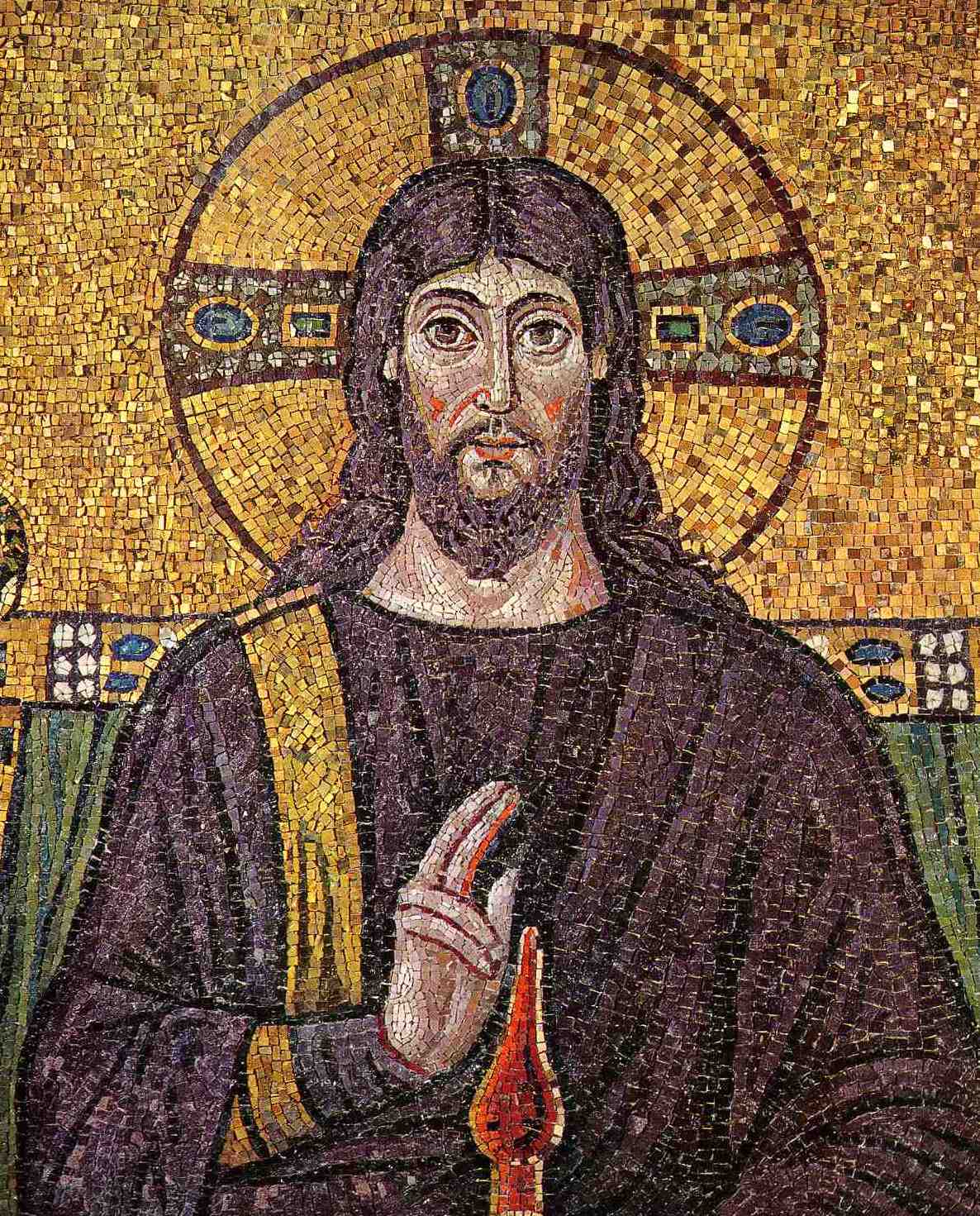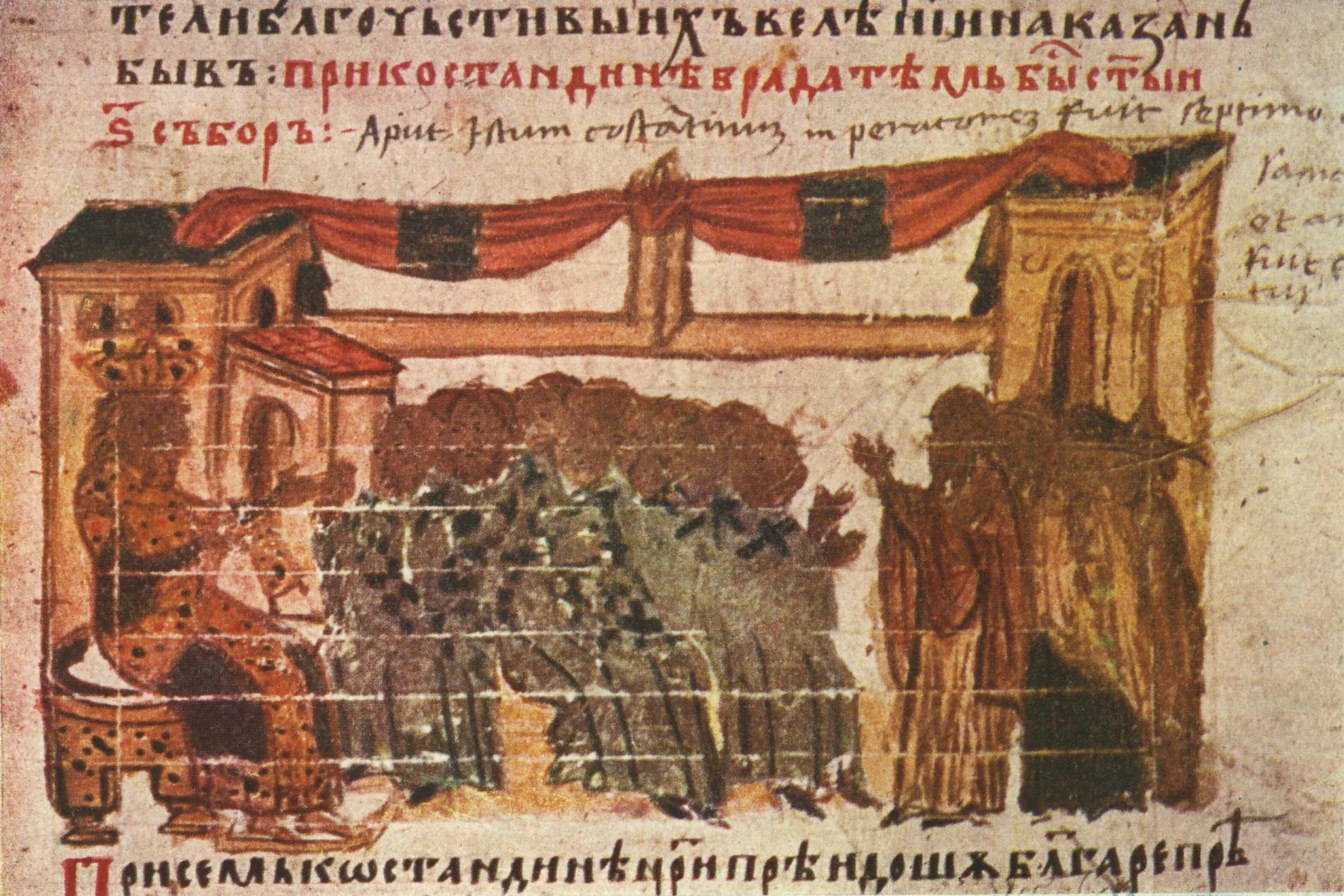|
Emperor Constantine IV
Constantine IV ( la, Constantinus; grc-gre, Κωνσταντῖνος, Kōnstantînos; 650–685), called the Younger ( la, iunior; grc-gre, ὁ νέος, ho néos) and sometimes incorrectly the Bearded ( la, Pogonatus; grc-gre, Πωγωνᾶτος, Pōgōnãtos) out of confusion with his father, was Eastern Roman emperor from 668 to 685. His reign saw the first serious check to nearly 50 years of uninterrupted Islamic expansion, most notable when he successfully defended Constantinople from the Arabs. His calling of the Sixth Ecumenical Council saw the end of the monothelitism controversy in the Byzantine Empire; for this, he is venerated as a saint in the Eastern Orthodox Church, with his feast day on September 3.September 3/September 16 Orthodox Calendar (PRAVOSLAVIE.RU). Early career The e ...[...More Info...] [...Related Items...] OR: [Wikipedia] [Google] [Baidu] |
Sant'Apollinare In Classe
The Basilica of Sant' Apollinare in Classe ("Saint Apollinaris in Classe") is a church in Classe, Ravenna, Italy, consecrated on 9 May 549 by the bishop Maximian and dedicated to Saint Apollinaris, the first bishop of Ravenna and Classe. An important monument of Byzantine art, in 1996 it was inscribed with seven other nearby monuments in the UNESCO World Heritage List, which described it as "an outstanding example of the early Christian basilica in its purity and simplicity of its design and use of space and in the sumptuous nature of its decoration". History Work on Sant'Apollinare in Classe started at the beginning of 6th century by order of Bishop Ursicinus, using money from the Roman banker Iulianus Argentarius. It was certainly located next to a Christian cemetery, and quite possibly on top of a pre-existing pagan one, as some of the ancient tombstones were re-used in its construction. At that time, Classe was located on the shore and was the ancient home port of ... [...More Info...] [...Related Items...] OR: [Wikipedia] [Google] [Baidu] |
Church Of The Holy Apostles
The Church of the Holy Apostles ( el, , ''Agioi Apostoloi''; tr, Havariyyun Kilisesi), also known as the ''Imperial Polyándreion'' (imperial cemetery), was a Byzantine Eastern Orthodox church in Constantinople, capital of the Eastern Roman Empire. The first structure dated to the 4th century, though future emperors would add to and improve upon it.Krautheimer (1992) It was second in size and importance only to the Hagia Sophia among the great churches of the capital. When Fall of Constantinople, Constantinople fell to the Ottoman Empire, Ottomans in 1453, the Holy Apostles briefly became the seat of the Ecumenical Patriarch of the Eastern Orthodox Church. Three years later the dilapidated edifice was abandoned, and the patriarchate was moved to the Pammakaristos Church, Theotokos Pammakaristos Church. In 1461, the church of the Holy Apostles was demolished by the Ottomans to make way for the Fatih Mosque, Istanbul, Fatih Mosque.Müller-Wiener (1977) p. 406 History The ori ... [...More Info...] [...Related Items...] OR: [Wikipedia] [Google] [Baidu] |
Byzantine Empire
The Byzantine Empire, also referred to as the Eastern Roman Empire or Byzantium, was the continuation of the Roman Empire primarily in its eastern provinces during Late Antiquity and the Middle Ages, when its capital city was Constantinople. It survived the fragmentation and fall of the Western Roman Empire in the 5th century AD and continued to exist for an additional thousand years until the fall of Constantinople to the Ottoman Empire in 1453. During most of its existence, the empire remained the most powerful economic, cultural, and military force in Europe. The terms "Byzantine Empire" and "Eastern Roman Empire" were coined after the end of the realm; its citizens continued to refer to their empire as the Roman Empire, and to themselves as Romans—a term which Greeks continued to use for themselves into Ottoman times. Although the Roman state continued and its traditions were maintained, modern historians prefer to differentiate the Byzantine Empire from Ancient Rome ... [...More Info...] [...Related Items...] OR: [Wikipedia] [Google] [Baidu] |
Monothelitism
Monothelitism, or monotheletism (from el, μονοθελητισμός, monothelētismós, doctrine of one will), is a theological doctrine in Christianity, that holds Christ as having only one will. The doctrine is thus contrary to dyothelitism, a Christological doctrine that holds Christ as having two wills (divine and human). Historically, ''monothelitism'' was closely related to monoenergism, a theological doctrine that holds Jesus Christ as having only one energy. Both doctrines were at the center of Christological disputes during the 7th century. Theological notions related to the ''oneness'' of Christ's will emerged as a result of some earlier Christological controversies, that were related to monophysitism as formulated by Eutyches (d. 456), and miaphysitism as formulated by non-Chalcedonian followers of Cyril of Alexandria (d. 444). Since the notion of Christ's ''one nature'' implied the ''oneness'' of his will, ecclesiastical and political elites of the Eastern Roman ... [...More Info...] [...Related Items...] OR: [Wikipedia] [Google] [Baidu] |
Sixth Ecumenical Council
The Third Council of Constantinople, counted as the Sixth Ecumenical Council by the Eastern Orthodox and Catholic Churches, as well by certain other Western Churches, met in 680–681 and condemned monoenergism and monothelitism as heretical and defined Jesus Christ as having two energies and two wills (divine and human).George Ostrogorsky, ''History of the Byzantine State'' (Rutgers University Press, 1995), 127. Background The council settled a set of theological controversies that went back to the sixth century but had intensified under the emperors Heraclius () and Constans II (). Heraclius had set out to recover much of the part of his empire lost to the Persians and had attempted to bridge the controversy with monophysitism, which was particularly strong in Syria and Egypt, by proposing a moderate theological position that had as good support in the tradition as any other. The result was first monoenergism, i.e. that Christ, though existing in two natures (divine and h ... [...More Info...] [...Related Items...] OR: [Wikipedia] [Google] [Baidu] |
Umayyad Caliphate
The Umayyad Caliphate (661–750 CE; , ; ar, ٱلْخِلَافَة ٱلْأُمَوِيَّة, al-Khilāfah al-ʾUmawīyah) was the second of the four major caliphates established after the death of Muhammad. The caliphate was ruled by the Umayyad dynasty ( ar, ٱلْأُمَوِيُّون, ''al-ʾUmawīyūn'', or , ''Banū ʾUmayyah'', "Sons of Umayyah"). Uthman ibn Affan (r. 644–656), the third of the Rashidun caliphs, was also a member of the clan. The family established dynastic, hereditary rule with Muawiya ibn Abi Sufyan, long-time governor of Greater Syria, who became the sixth caliph after the end of the First Fitna in 661. After Mu'awiyah's death in 680, conflicts over the succession resulted in the Second Fitna, and power eventually fell into the hands of Marwan I from another branch of the clan. Greater Syria remained the Umayyads' main power base thereafter, with Damascus serving as their capital. The Umayyads continued the Muslim conquests, incorpo ... [...More Info...] [...Related Items...] OR: [Wikipedia] [Google] [Baidu] |
Siege Of Constantinople (674–678)
The first Arab siege of Constantinople in 674–678 was a major conflict of the Arab–Byzantine wars, and the first culmination of the Umayyad Caliphate's expansionist strategy towards the Byzantine Empire, led by Caliph Mu'awiya I. Mu'awiya, who had emerged in 661 as the ruler of the Muslim Arab empire following a civil war, renewed aggressive warfare against Byzantium after a lapse of some years and hoped to deliver a lethal blow by capturing the Byzantine capital, Constantinople. As reported by the Byzantine chronicler Theophanes the Confessor, the Arab attack was methodical: in 672–673 Arab fleets secured bases along the coasts of Asia Minor, and then proceeded to install a loose blockade around Constantinople. They used the peninsula of Cyzicus near the city as a base to spend the winter, and returned every spring to launch attacks against the city's fortifications. Finally, the Byzantines, under Emperor Constantine IV, managed to destroy the Arab navy using a new inve ... [...More Info...] [...Related Items...] OR: [Wikipedia] [Google] [Baidu] |
Islamic
Islam (; ar, ۘالِإسلَام, , ) is an Abrahamic monotheistic religion centred primarily around the Quran, a religious text considered by Muslims to be the direct word of God (or '' Allah'') as it was revealed to Muhammad, the main and final Islamic prophet.Peters, F. E. 2009. "Allāh." In , edited by J. L. Esposito. Oxford: Oxford University Press. . (See alsoquick reference) " e Muslims' understanding of Allāh is based...on the Qurʿān's public witness. Allāh is Unique, the Creator, Sovereign, and Judge of mankind. It is Allāh who directs the universe through his direct action on nature and who has guided human history through his prophets, Abraham, with whom he made his covenant, Moses/Moosa, Jesus/Eesa, and Muḥammad, through all of whom he founded his chosen communities, the 'Peoples of the Book.'" It is the world's second-largest religion behind Christianity, with its followers ranging between 1-1.8 billion globally, or around a quarter of the world's po ... [...More Info...] [...Related Items...] OR: [Wikipedia] [Google] [Baidu] |
List Of Byzantine Emperors
This is a list of the Byzantine emperors from the foundation of Constantinople in 330 AD, which marks the conventional start of the Eastern Roman Empire, to its fall to the Ottoman Empire in 1453 AD. Only the emperors who were recognized as legitimate rulers and exercised sovereign authority are included, to the exclusion of junior co-emperors (''symbasileis'') who never attained the status of sole or senior ruler, as well as of the various usurpers or rebels who claimed the imperial title. The following list starts with Constantine the Great, the first Christian emperor, who rebuilt the city of Byzantium as an imperial capital, Constantinople, and who was regarded by the later emperors as the model ruler. It was under Constantine that the major characteristics of what is considered the Byzantine state emerged: a Roman polity centered at Constantinople and culturally dominated by the Greek East, with Christianity as the state religion. The Byzantine Empire was the direct lega ... [...More Info...] [...Related Items...] OR: [Wikipedia] [Google] [Baidu] |
Right-Believing
Right-Believing (russian: благоверный, el, εὐσεβής, la, pius), also called under the prefix The most Orthodox, is an Orthodox saint title for monarchs who were canonized for a righteous life. They do not belong to martyrs or passion bearers. The saint title was initially given to Byzantine Emperors and their wives by the Constantinople Orthodox Church in the period of Ecumenical Councils, but other local Orthodox churches took that tradition, including the Russian Orthodox Church. Russian Right-Believing princes include Andrey Bogolyubsky, Davyd Yuryevich Alexander Nevsky, and Dmitry Donskoy. Ukrainian Right-Believing leaders include Petro Konashevych-Sahaidachny. See also * List of Eastern Orthodox saint titles The holy figures of the Eastern Orthodox Church (and of the Eastern Catholic Churches of the Byzantine Rite) have various customary saint titles with which they are commemorated on the liturgical calendar and in Divine Services. The following l ... [...More Info...] [...Related Items...] OR: [Wikipedia] [Google] [Baidu] |
Eastern Orthodoxy
Eastern Orthodoxy, also known as Eastern Orthodox Christianity, is one of the three main Branches of Christianity, branches of Chalcedonian Christianity, alongside Catholic Church, Catholicism and Protestantism. Like the Pentarchy of the first millennium, the mainstream (or "Canon law of the Eastern Orthodox Church, canonical") Eastern Orthodox Church is Organization of the Eastern Orthodox Church, organised into autocephalous churches independent from each other. In the 21st century, the Organization of the Eastern Orthodox Church#Autocephalous Eastern Orthodox churches, number of mainstream autocephalous churches is seventeen; there also exist Organization of the Eastern Orthodox Church#Unrecognised churches, autocephalous churches unrecognized by those mainstream ones. Autocephalous churches choose their own Primate (bishop), primate. Autocephalous churches can have Ecclesiastical jurisdiction, jurisdiction (authority) over other churches, some of which have the status of "Auto ... [...More Info...] [...Related Items...] OR: [Wikipedia] [Google] [Baidu] |





.jpg)
